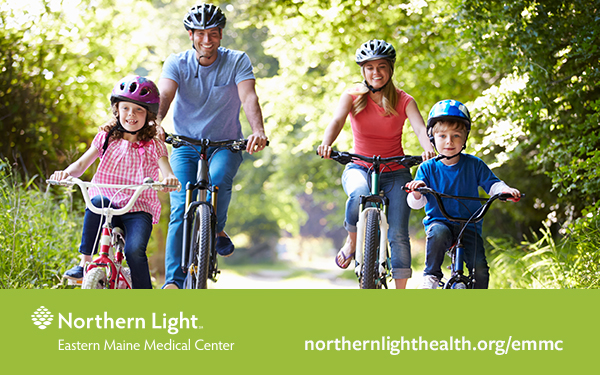
Northern Light Surgery and Trauma injury prevention tips: springtime activities
It’s March at last, and already, the days are getting longer and soon, the sun will be shining brighter! With the longer, warmer days fast approaching, more of us will be outside enjoying all that Maine has to offer. People walking, riding bicycles, and motorcycles will suddenly appear around us, so it is important to be aware of our surroundings, share the roadway and sidewalks, and put our cell phones away – distracted activity can cause accidents for everyone.
To increase safety while walking:
- Be alert, look, and listen
- Look all ways for traffic and other hazards.
- Use both your eyes and ears to watch for cars, trucks, and bicycles.
- Be seen, day or night
- Wear brightly colored, light-colored clothes for added visibility.
- Watch for cars pulling out of driveways, alleys, or blocking driveways.
- Carry a flashlight or wear blinking lights after dark.
- Add reflective gear for additional safety.
- Consider your walking route
- Use a sidewalk whenever you can. If there is no sidewalk, walk on the left side of the road facing traffic.
- Walk facing the traffic flow.
- Plan a safe walking route.
- Cross with care
- Before crossing the road, stop, look left, look right, and look left again, before crossing the road.
- Cross at a crosswalk whenever you can.
- At traffic lights, wait for the WALK sign to light up, and then look left, and right, and left again before crossing.
- Watch for turning cars at all intersections, even if the walk signal it lit.
- “Wait, Watch, and Wave” – be certain to wait until all cars have stopped in all lanes, and the drivers have seen you before you cross.
For increased safety while riding your bicycle:
- Wear your helmet the right way that fits properly
- Make sure your helmet fits correctly. It should be level and snug. If it slides around, you need to insert thicker pads.
- EYES: you should be able to see the very edge of your helmet when you look up past your eyebrows
- EARS: the straps should meet right under your ear lobes to form a Y
- MOUTH: the strap should be loose enough so you can breathe and insert a finger between the buckle and your skin, but tight enough that if you drop your jaw you can feel the helmet pull down on the top of your head.
- Dress bright for safety
- Wear light or bright colored clothing.
- Tuck in shoelaces or other strings/cords so they don’t dangle – they may get caught in the moving parts of your bicycle or motorcycle.
- Wear snug clothing as baggy clothing can also get caught in moving parts.
- Add reflective gear for additional safety.
- NEVER wear headphones while riding a bicycle.
- Obey the Rules of the Road
- Ride on the right side of the road, with the flow of traffic.
- Ride single file.
- Obey traffic signs, signals, and laws.
- Look back and signal before turning.
- Yield to people walking.
- Use lights if riding at night.
- Always stop at the end of your driveway – look left, right, and then left again before entering the road.
- If you feel unsafe, you can always walk beside your bicycle while pushing it.
When riding a motorcycle, riders are urged to be alert, make themselves visible, wear a Department of Transportation (DOT)-compliant motorcycle helmet, and always ride sober. In addition, make sure your motorcycle is in good working condition, never ride while using a cell phone, and know your local traffic laws.
For drivers of cars, trucks, and other motor vehicles, be aware, avoid distractions, and put your cell phone away! Remember, Maine law require hands-free phone calls only. Always be watching for what or who is around the next corner.
Be safe and bring on the warmer weather!
Source: Bicycle Coalition of Maine